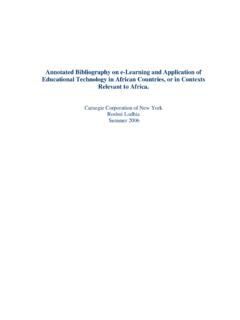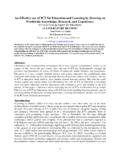Transcription of BARRIERS TO THE INTRODUCTION OF ICT INTO …
1 International Journal of Instruction July 2012 , e-ISSN: 1308-1470 p-ISSN: 1694-609X BARRIERS TO THE INTRODUCTION OF ICT into education IN DEVELOPING COUNTRIES: THE EXAMPLE OF BANGLADESH Md. Shahadat Hossain Khan PhD Candidate, Faculty of education and Social Work, The University of Sydney, NSW, Australia Mahbub Hasan Lecturer, Department of Technical and Vocational education (TVE), Islamic University of Technology (IUT), Bangladesh Che Kum Clement Prof., TVE Department, Islamic University of Technology (IUT), Bangladesh Within a very few years, Information and Communication Technology (ICT) has turned out to be an effective educational technology which promotes some dramatic changes in teaching and learning processes. Technologies allow students to work more productively than in the past, but the teacher s role in technology-rich classrooms is more demanding than ever (Keengwe, Onchwari et al.)
2 2008). ICT has the potential to transform the nature of education (improving teachers design work, enhancing the roles of students and teachers in the learning process and helping to create a collaborative learning environment, etc). Although ICT has the potential to improve the educational system to a great extent, developing countries are far from reaping these benefits because of certain BARRIERS . The aim of this paper is to present a comprehensive review of international articles relating to BARRIERS encountered when introducing ICT into classrooms. This review will help identify the factors that influence teachers decisions whether or not to implement ICT in teaching - learning situations. Connections will be made with existing literature to explore possible BARRIERS for introducing ICT into education in Bangladesh.
3 Further, this paper also offers a number of recommendations to reduce these BARRIERS and maximize the beneficial use of ICT on education . Key Words: educational technology, teachers' design works, student learning , ICT implementation 62 BARRIERS to the INTRODUCTION of ICT into education .. International Journal of Instruction, July 2012 , INTRODUCTION The growth of information and communication technologies (ICT) has dramatically reshaped teaching and learning processes in higher education (Pulkkinen, 2007; Wood, 1995). ICT for education is more critical today than ever before since its growing power and capabilities are triggering a change in the learning environments available for education (Pajo & Wallace, 2001). The use of ICT offers powerful learning environments and can transform the learning and teaching process so that students can deal with knowledge in an active, self directed and constructive way (Volman & Van Eck, 2001; de Corte et al.)
4 , 2003). At present ICT is considered as an important means to promote new methods of instruction ( teaching and learning ). It should be used to develop students' skills for cooperation, communication, problem solving and lifelong learning (Plomp et al., 1996; Voogt, 2003). Although computers and technology are prevalent throughout our society (Cuban, 2001), developing countries are far from reaping their benefits because of certain BARRIERS . The aim of this paper is to present a comprehensive review of international articles relating to BARRIERS encountered when introducing ICT into classrooms. This review will help identify the factors that influence teachers decisions whether or not to implement ICT in teaching - learning situations. Connections will be made with existing literature to explore possible BARRIERS for introducing ICT into education in Bangladesh.
5 Understanding the pedagogical, psychological and cognitive BARRIERS to the successful use of information technology may be a vital precondition for improving the utilization of computers and other technological aids in the educational process (Benzie, 1995). It is hoped that this paper will be useful for the educators, policymakers and other decision makers who are directly involved in introducing ICT into education in Bangladesh During the last two decades, the implementation of ICT in education has become an important topic in research on educational reform (Drent and Meelissen 2008). Research findings over the past two decades provide some evidence as to the positive effects of the use of information and communications technology (ICT) on pupils learning (Mumtaz, 2000; Hattie, 2009).
6 Sanyal (2001) states that there are four ways ICT can support basic education : (i) supporting education in schools, (ii) providing non-formal education for out-of-school children and adults, (iii) supporting pre-service distance education of teachers and their in-service professional development, and (iv) enhancing the management of schools. Sanyal (2001) makes a cautionary observation by quoting IIEP (1995), Putting computers in classrooms and wiring up schools does not of itself create exciting new learning Khan, Hasan & Clement 63 International Journal of Instruction, July 2012 , situations that are about changing the ethos of classrooms and the culture of institutions . By adopting ICT, we can offer high quality education . Ehrmann (1994) identified four distinct faces of quality education , which can be supported by ICT: learning by doing, real time conversation, delayed time conversation and directed instruction.
7 Hawkridge et al (1990) suggested that the use of ICT could improve performance, teaching , and administration, have a positive impact on education as a whole, and develop relevant skills in the disadvantaged communities - helping in liberation and transformation. The Dakar Framework for Action (World education Forum, Dakar, Senegal, April 2000) also stressed the use of ICT for achieving education For All (EFA) goals and recommended, ICT must be harnessed to support EFA goals at an affordable cost. These technologies have great potential for knowledge dissemination, effective learning and the development of more efficient education services. Technology should be used as a tool to support educational objectives such as skills for searching and assessing information, cooperation, communication and problem solving - which are important for the preparation of children for the knowledge society (Drent and Meelissen 2008).
8 Cox et al (1999) carried out a study examining the factors relating to the uptake of ICT in teaching . The results showed that the teachers who are already regular users of ICT have confidence in using ICT, perceive it to be useful for their personal work and for their teaching and plan to extend their use further in the future. The factors that were found to be the most important to these teachers in their teaching were: making the lessons more interesting, easier, more fun for them and their pupils, more diverse, more motivating for the pupils and more enjoyable. Additional, more personal, factors were: improving presentation of materials, allowing greater access to computers for personal use, giving more power to the teacher in the school, giving the teacher more prestige, making the teachers administration more efficient and providing professional support through the Internet ICT enhances higher education in a number of ways: It enables the effective storing/sorting of information, and can offer new fast ways of communication; It enables the reduction of information quantity towards a higher quality and better structure; It can be integrated into teaching and learning strategies and used to support relative learning theories.
9 And ICT (computers, Inter and Intranet) can be used to create new types of interactive learning media for improved quality, equity, and access in higher education (Rosswall, 1999). 64 BARRIERS to the INTRODUCTION of ICT into education .. International Journal of Instruction, July 2012 , Researchers have also found that computers enhance teaching and learning by providing opportunities to practice and to analyze, offering better access to relevant articles and teaching and learning materials. Every classroom teacher should use learning technologies to enhance their students' learning in every subject - because ICT can engage the thinking, decision making, problem solving and reasoning behaviors of students (Grabe & Grabe, 2001). In fact, innovative use of ICT can facilitate student-centered learning (Drent, 2005), engage students in constructivist classrooms and enhance their social interaction (Dodge, Colker, & Heroman, 2003).
10 It has been shown to improve their cognitive development (Nir-Gal & Klein, 2004), increase creativity (O Hara, 2008), and improve their problem solving skills (Sarama & Clements, 2001). The International Society for Technology in Educational (ISTE) emphasizes that teachers of today should prepare to provide technology-based learning opportunities for their students (Hamidi, Meshkat et al. 2011). ICT use has increased dramatically over the last few years. In the developed regions, the percentage remains much higher than in the developing world (MDG Report 2010) (see Fig. 1). On the other hand, adoption and usage of ICT are not restricted to the developed countries, and several developing countries have adopted technology in their educational systems (Ihmeideh, 2009).




